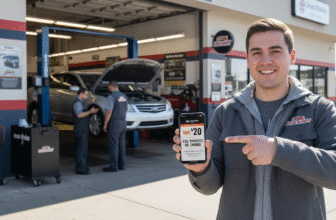
Used Tahoe for Sale: Your Ultimate Buyer’s Guide to America’s Favorite Full-Size SUV
There are few vehicles on the road today that command the presence and respect of the Chevrolet Tahoe. It’s an American icon, a rolling testament to space, power, and capability. For decades, it has been the go-to choice for large families, law enforcement agencies, and anyone needing to tow a boat to the lake on Saturday and drive the carpool on Monday. But let’s be honest, a brand-new Tahoe comes with a brand-new, hefty price tag. That’s where the magic of the used market comes in. A used Tahoe for sale isn’t just a purchase; it’s a smart investment in a vehicle built to last, offering incredible value and utility for a fraction of the original cost.
But navigating the vast sea of used Tahoes can be daunting. With multiple generations, various trim levels, and a few well-known quirks, how do you find the right one? How do you avoid buying someone else’s problem? Fear not. This comprehensive guide is your co-pilot, designed to walk you through everything you need to know to find, inspect, and purchase the perfect used Tahoe for your needs and budget.
Why a Used Chevrolet Tahoe Should Be at the Top of Your List
Before we dive into the nuts and bolts of each generation, let’s talk about why a used Tahoe is such a compelling option. It boils down to a few key principles that have defined this SUV since its inception.
- Unbeatable Value: The single biggest hit a vehicle takes in value is depreciation, and it happens the fastest in the first few years. By buying a Tahoe that’s a few years old, you let the original owner absorb that massive financial blow. You get a vehicle that might have 80% of its useful life left for 50% (or less) of its original price.
- Proven, Tough-as-Nails Engineering: Tahoes are built on a robust, body-on-frame truck platform. This construction is inherently durable and capable of handling serious work and abuse. Their V8 engines, particularly the legendary Vortec and modern EcoTec3 families, are known for their longevity, often racking up well over 200,000 miles with proper maintenance.
- Do-It-All Versatility: Need to seat up to nine people? Check. Need to tow a 7,000-pound trailer? Check. Need to haul a load of lumber from the home improvement store? Fold the seats down, and you’re good to go. The Tahoe is the Swiss Army knife of vehicles, adapting to whatever life throws your way.
- Affordable Maintenance: Thanks to its shared parts with Silverado pickups and the sheer number of them on the road, parts are plentiful and affordable. Any competent independent mechanic can work on a Tahoe, meaning you won’t be tethered to expensive dealership service departments for routine repairs.
A Deep Dive: Understanding the Tahoe Generations

Knowing the differences, strengths, and weaknesses of each generation is the single most powerful tool you have as a buyer. It allows you to target the specific years that best fit your priorities.
The Classic Square Body: First Generation (1995-2000, GMT400)
This is the one that started it all. Born from the K5 Blazer, the first-gen Tahoe was available in both two-door and four-door configurations. They are simple, rugged, and increasingly sought after by enthusiasts.
- The Good: Powered almost exclusively by the legendary 5.7L “Vortec 350” V8 engine, a powerhouse known for its reliability and torque. These Tahoes are mechanically simple, making them easy and cheap to work on. They have a classic, tough look that many still love.
- The Not-so-Good: They are old. Interiors will show significant wear, plastics can be brittle, and rust is a major concern, especially in the rocker panels, cab corners, and above the rear wheel wells. The ride is more truck-like and less refined than later models.
- What to Look For: A solid frame is non-negotiable. Check the 4L60E automatic transmission for smooth shifting, as they can be a weak point. Look for extensive service records. These are best for enthusiasts, weekend adventurers, or those on a very tight budget who are comfortable with older vehicle ownership.
The Era of Refinement: Second Generation (2000-2006, GMT800)
Many argue this is the peak generation for reliability and balanced design. The GMT800 Tahoe was a massive leap forward in comfort, ride quality, and interior design, without adding too much complexity.
- The Good: This generation introduced the now-legendary Vortec 4.8L and 5.3L V8 engines. The 5.3L is the one to get, offering a fantastic blend of power and dependability. The ride is significantly smoother, and the interior is a much nicer place to be. These trucks are known to be workhorses, easily capable of 300,000+ miles.
- The Not-so-Good: Common issues include failing stepper motors in the instrument cluster (causing gauges to stick or read incorrectly), rust-prone brake and fuel lines (a critical check!), and the occasional water pump or fuel pump failure. Rocker panels and rear quarter panels are still susceptible to rust.
- What to Look For: The “best year” is subjective, but many favor the 2005-2006 models as they had worked out most of the early kinks. Get underneath and inspect those brake and fuel lines thoroughly. Check that all gauges work on the test drive. The Z71 off-road package from this era is particularly desirable.
The Modern Age Begins: Third Generation (2007-2014, GMT900)
With a sleek, aerodynamic design and a vastly improved interior, the GMT900 Tahoe brought the model firmly into the 21st century. It introduced more technology and a focus on fuel economy, which came with a major mechanical caveat.
- The Good: The interior quality is a night-and-day difference from the previous generation. They offer a comfortable, quiet ride. Higher trim levels like the LTZ feel genuinely luxurious, with options for heated/cooled seats and premium sound systems.
- The Not-so-Good: This generation’s 5.3L V8 featured Active Fuel Management (AFM), a system that deactivates four cylinders under light load to save fuel. Unfortunately, this system is the generation’s Achilles’ heel, linked to excessive oil consumption and potential lifter failure, which can be a catastrophic engine repair. Another common complaint is cracked dashboards, especially on vehicles from hot climates.
- What to Look For: Service history is paramount. Ask if the AFM system has ever been addressed or if the vehicle has had any issues with oil consumption. Many owners opt to purchase a “disabler” device that plugs into the OBD-II port to keep the engine in V8 mode, which can prevent the issue. If you can find a model with the 6.2L V8 (found in some LTZ and Denali equivalent models), it often did not have AFM and is a more robust choice.
The Tech-Forward Powerhouse: Fourth Generation (2015-2020, K2XX)
A complete redesign brought a bold, squared-off look and a host of modern technology. These Tahoes are incredibly popular on the used market, offering many of the features of a new vehicle at a significant discount.
- The Good: The direct-injected 5.3L and 6.2L EcoTec3 engines provide more power and better fuel economy. The cabin is quiet and comfortable, with modern infotainment systems (Apple CarPlay/Android Auto were added in 2016). Safety features like blind-spot monitoring and forward collision alert became common.
- The Not-so-Good: Early models (2015-2016) with the 6-speed automatic are generally solid, but many later models with the 8-speed automatic transmission are known for a “Chevy Shake” or shuddering issue, often requiring a specific fluid flush or, in worst cases, a torque converter replacement. A/C condensers are another known weak point, prone to leaking. The AFM system is still present, so oil consumption can still be a concern.
- What to Look For: On your test drive, pay close attention to the transmission’s behavior, especially during light acceleration between 30-50 mph. If you feel a shudder, be wary. Favor 2017 and newer models if your budget allows, as they had some of the early tech bugs worked out. A CPO (Certified Pre-Owned) model can offer great peace of mind here.
Your Pre-Purchase Inspection Checklist: Don’t Buy Blind
Found a promising candidate? Great. Now it’s time to play detective. A thorough inspection can save you thousands in future repairs. If you’re not mechanically inclined, spending $100-$200 on a pre-purchase inspection (PPI) from a trusted independent mechanic is the best money you will ever spend.
- The Walk-Around: Look down the body lines for ripples that could indicate past accidents. Check for inconsistent panel gaps. Inspect the tires for uneven wear, which could signal alignment or suspension problems. Get on your hands and knees and look for rust on the frame, rocker panels, and brake lines.
- The Interior Deep Dive: Test every single button, switch, and knob. Power windows, locks, seats, radio, and especially the A/C and heat. A non-functional A/C can be a $1,000+ repair. Check for musty smells or water stains on the headliner, which could mean a leaking sunroof or roof rack.
- The All-Important Test Drive:
- Cold Start: If possible, start the engine when it’s cold. Listen for any loud ticking or knocking sounds.
- Acceleration: Does it accelerate smoothly? Any hesitation?
- Transmission: Pay close attention to the shifts. Are they smooth or harsh? Do you feel any shuddering?
- Braking: Does the vehicle pull to one side when you brake? Is there a pulsing in the pedal (warped rotors)?
- Suspension: Drive over some bumpy roads. Listen for any clunks, pops, or rattles.
- 4WD System: If equipped, find a safe place (like a gravel lot) to engage 4-High and 4-Low to ensure the transfer case is working properly.
- The Paper Trail: Always, always, always run a Vehicle History Report from a service like CarFax or AutoCheck. It will reveal reported accidents, title issues (like salvage or flood damage), and sometimes even service history. Ask the seller for any maintenance records they have. A thick stack of receipts is a fantastic sign of a well-cared-for vehicle.
Decoding the Trim Levels
Understanding the trim hierarchy will help you narrow your search for the features you want.
- LS: The base model. Typically comes with cloth seats and fewer creature comforts, but all the core capability. A great choice for a no-frills workhorse or family hauler on a budget.
- LT: The sweet spot and the most common trim. It’s the perfect middle ground, often adding features like leather seating (sometimes optional), a better sound system, and more convenience features.
- LTZ / Premier: The top of the line. Before 2017, it was the LTZ; afterward, it was renamed Premier. These are loaded with luxury: premium leather, advanced safety tech, navigation, sunroofs, and often exclusive features like Magnetic Ride Control for a smoother ride.
- Z71: The off-road-focused package. Includes all-terrain tires, a unique front fascia for a better approach angle, skid plates, and off-road-tuned suspension.
- RST: A street-performance appearance package introduced on the 4th generation, often paired with the powerful 6.2L V8 and other performance upgrades.
Your Perfect Tahoe is Out There
Buying a used Chevrolet Tahoe is one of the smartest moves you can make if you need a vehicle that can truly do it all. They are spacious, powerful, and built on a legacy of toughness. By arming yourself with knowledge of the different generations, being aware of the potential trouble spots, and performing a diligent inspection, you can confidently navigate the market.
Take your time, do your homework, and don’t be afraid to walk away from a deal that doesn’t feel right. The right used Tahoe for you is out there waiting—ready for countless family road trips, weekend projects, and daily adventures for years to come.







